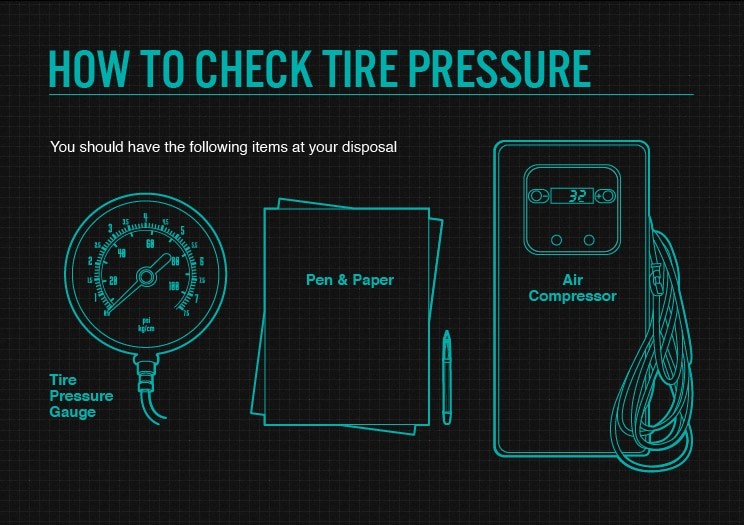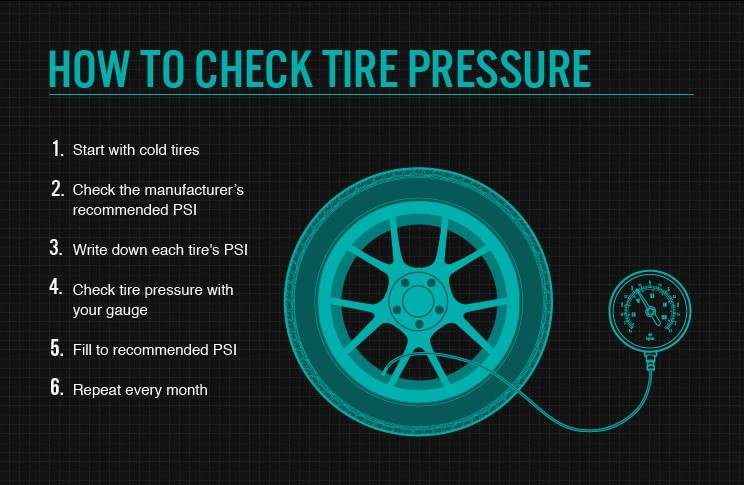Maintaining your vehicle’s tires at the correct pressure is crucial for safety, tire longevity, and fuel efficiency. A simple tool, the tire pressure gauge, is all you need to ensure your tires are properly inflated. Both underinflated and overinflated tires can lead to problems, from premature wear to compromised handling. Regularly checking your tire pressure, ideally monthly, is a key part of vehicle maintenance. This guide will walk you through how to use a tire pressure gauge and maintain optimal tire inflation.
Essential Items for Checking Tire Pressure
Before you begin, gather these simple tools:
- Tire pressure gauge: You can choose between a digital or a standard gauge. Both types are readily available at auto parts stores.
- Air compressor: For inflating tires if needed. Portable air compressors that work with your car battery or 12V port are convenient. Gas stations also have air compressors, usually for a small fee.
- Pen and paper (or your phone): To record pressure readings for each tire.
 Items needed to check tire pressure including a tire pressure gauge and air compressor
Items needed to check tire pressure including a tire pressure gauge and air compressor
Step-by-Step Guide: How to Check Tire Pressure
Follow these steps to accurately check your tire pressure using a Tire Gauge:
1. Begin with Cold Tires for Accuracy
 Image depicting steps to check tire pressure for accurate readings
Image depicting steps to check tire pressure for accurate readings
For the most accurate reading, tire manufacturers recommend checking tire pressure when tires are “cold.” Cold tires mean your vehicle has been parked for three hours or more, or driven less than a mile at a moderate speed. Driving heats up the air inside the tire, increasing pressure and leading to an inaccurate reading. The recommended PSI (pounds per square inch) specified by vehicle manufacturers is always based on cold tire pressure. PSI is the standard unit of measurement you’ll see on your tire pressure gauge.
2. Locate the Recommended PSI for Your Vehicle
The correct cold tire PSI for your vehicle’s front and rear tires can be found in a few places:
- Driver’s side door jamb: Often a sticker is located here with tire information and recommended pressures.
- Owner’s manual: Your vehicle’s manual will have a section dedicated to tire specifications and inflation recommendations.
If you are unable to locate this information, it’s best to consult your vehicle dealer, the vehicle manufacturer’s website, or a qualified tire professional to ensure you’re using the correct PSI.
3. Record the Recommended PSI for Each Tire Position
Note down the recommended PSI for both your front and rear tires, especially if they require different pressures. This will help you stay organized as you check each tire and ensures you inflate them correctly.
4. Use Your Tire Pressure Gauge to Check Each Tire
- Remove the valve cap: Unscrew the valve cap from the valve stem of one tire and set it aside in a safe place.
- Position the gauge: Press the tire pressure gauge firmly onto the tire valve stem. Apply consistent pressure until the hissing sound of air escaping stops and the gauge provides a reading.
- Read the gauge:
- Standard gauge: Air pressure will extend a small bar from the gauge’s base. Measurement markings are etched onto this bar.
- Digital gauge: The pressure reading will be displayed clearly on the digital screen.
- Record the reading: Write down the PSI reading for that tire.
- Repeat: Follow this process for each of the four tires.
5. Inflate Tires to the Recommended PSI if Needed
If any of your tires are below the recommended PSI, use an air compressor to add air.
- Using an air compressor: Air compressors vary in design, so carefully read the instructions for the specific model you are using to ensure proper operation.
- Gas station air compressors: When using a gas station air compressor, park your vehicle strategically so the hose can reach all four tires. Insert payment as required to activate the machine. To inflate, attach the hose end to the tire valve stem and press the lever to release air into the tire.
- Adjusting for “hot” tires at gas stations: If you must inflate tires when they are “hot” (after driving), inflate them to 4 PSI (14 kPa) above the recommended cold inflation pressure. Remember to recheck and adjust the pressure to the recommended cold pressure once the tires have cooled down.
- Recheck pressure after inflation: After adding air, use your tire pressure gauge again to confirm you’ve reached the correct PSI. It’s acceptable to slightly overfill, as you can easily release air if needed. However, never drive on overinflated tires.
6. Make Monthly Tire Pressure Checks a Habit
Regularly checking your tire pressure each month is the best way to proactively maintain optimal tire inflation. Consistent checks ensure your tires remain at the correct PSI, maximizing tire life, safety, and fuel efficiency.
Tire Pressure Gauge Accuracy: Why It Matters
The accuracy of your tire pressure gauge is critical for obtaining reliable readings. Investing in a quality, accurate tire pressure gauge is a worthwhile investment in vehicle maintenance and safety, and they are available at reasonable prices.
- Digital vs. Standard: Digital tire pressure gauges typically offer precise readings. However, they rely on batteries, so consider a standard gauge if battery replacement is a concern.
- Personal Gauge vs. Service Station Gauges: It’s always preferable to use your personal tire pressure gauge rather than the gauges attached to air hoses at service stations. Public gauges are exposed to weather and frequent use, which can compromise their accuracy over time. For dependable readings, rely on your own tire pressure gauge.
By understanding how to use a tire pressure gauge and making regular tire pressure checks a part of your vehicle maintenance routine, you can ensure safer driving, extend the life of your tires, and improve your vehicle’s fuel economy.
